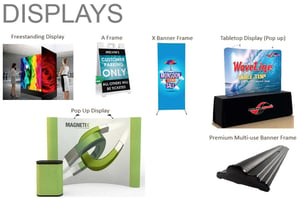
The following post was originally published by Printing Impressions. To read more of their content, subscribe to their newsletter, Today on PIWorld.
 Printers who create transactional documents rely on established workflows designed to generate millions of variable documents containing sensitive information like billing and payment amounts, purchases, insurance claim information, utility usage, or medical procedures. If that sounds like your business I can’t fault you for thinking your operation isn’t set up for low-volume, wide-format print applications like banners and signs.
Printers who create transactional documents rely on established workflows designed to generate millions of variable documents containing sensitive information like billing and payment amounts, purchases, insurance claim information, utility usage, or medical procedures. If that sounds like your business I can’t fault you for thinking your operation isn’t set up for low-volume, wide-format print applications like banners and signs.
These two print applications seem to have nothing in common. But is that really true?
Though the devices are different, printers produce wide-format jobs on digital devices, just like transactional documents. Color and resolution is important in both cases, and both require strenuous quality control processes. Mistakes in each genre are expensive. In the high-speed world of transactional documents, errors are quickly applied to thousands of documents resulting in waste, reruns and embarrassment. When a sign printer makes a mistake, it takes a long time and lots of ink and material before it becomes visible. And nothing is more embarrassing than an error that’s 10-feet wide!
Transactional Printing Trending Down
Something that is not the same when comparing transactional printing and wide-format printing is the growth trend. Volumes of transactional print are decreasing every year while large-format print is growing at an annual rate of over 11%.
Therefore I believe transactional printers should consider adding wide-format to their schedule of services. I’ve spoken with several companies about their concerns for shrinking transactional document print revenue. Wide-format definitely interests them. Diversification is a strategy and wide-format is an interesting area of opportunity.
Easy Entry into Wide Format
I am not suggesting transactional document printers should immediately run out and buy wide-format devices for their production facilities. There’s a less dramatic way to get into the wide-format business that allows printing companies to experiment with the concept without committing to huge capital expenditures.
I recommend outsourcing this work to well-established commercial print providers willing to produce custom signs, banners, car wraps and other types of materials at wholesale prices. Some of these companies operate regional print centers established for just this type of relationship. This way, transactional printers can offer services to their existing customers. They needn’t worry about the pressure of selling enough wide-format work to pay for the company’s investment in new print devices.
If the business takes off and you can justify bringing the work in-house, go for it! If not, continue subcontracting the work while your company uses these applications to boost revenue and strengthen relationships with your transactional document customers who also have needs for wide format printing.
A Competitive Advantage
Here’s a great example of how these two printing technologies can reinforce each other:
Suppose your company prints and mails water bills for a municipality or property tax bills for a county. As you know, those applications are always at risk as the government entities strive to lower their costs. Regulations may force governments to solicit bids when contracts are approaching expiration and could require them to award the work to the lowest bidder. That’s not good news for the incumbent print/mail service provider. A competitor offering savings of only a few cents per bill can lure the customer away from you. To keep the business, you might find it necessary to accept slimmer profit margins.
expiration and could require them to award the work to the lowest bidder. That’s not good news for the incumbent print/mail service provider. A competitor offering savings of only a few cents per bill can lure the customer away from you. To keep the business, you might find it necessary to accept slimmer profit margins.
Government entities always need signs, wraps and banners for community events, official vehicles, buildings and public places. The wide-format content and transactional document jobs can solidify the account and differentiate your company from competitors.
Protect Your Business-Diversify!
Wide-format printing and signs offer more attractive profit margins than transactional printers can ever expect to enjoy for the work their customers view as a commodity. Adding wide-format to your business would be a wise move that protects your company from shifts in technology that could cause sudden decreases in transactional document volumes.

In 2001, Roger Gimbel founded Gimbel & Associates, an international consulting firm providing business and market development services, skills training, and expert public speaking in the graphic communications and digital solutions industry. The mission of Gimbel & Associates is to help clients identify new business opportunities and implement leading-edge solutions using expertise in organizational development, technology selection, implementation, and work processes.
Roger oversees a team of Consultants with expertise in sales training, workflow analysis, MicroModeling, multichannel marketing, marketing plans, transactional printing, trans-promotional applications and creative strategies for mergers and acquisitions, business development workshops and seminars.
 Vanguard Digital and Durst Bring Innovative Vision to the 2025 ISA Expo
Vanguard Digital and Durst Bring Innovative Vision to the 2025 ISA Expo
 How Fujifilm Supports the Promotional Products Printing Market
How Fujifilm Supports the Promotional Products Printing Market
 How to UV Print on Baseballs: Best Practices and Common Challenges
How to UV Print on Baseballs: Best Practices and Common Challenges
 Roland DGA Unveils New Flatbed Printer
Roland DGA Unveils New Flatbed Printer
 Arcus Printers Debuts New Flatbed Printer
Arcus Printers Debuts New Flatbed Printer
 The UV Printing Advantage: How to Customize Promotional Products with Ease
The UV Printing Advantage: How to Customize Promotional Products with Ease








